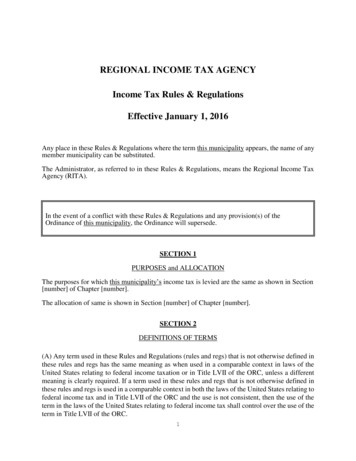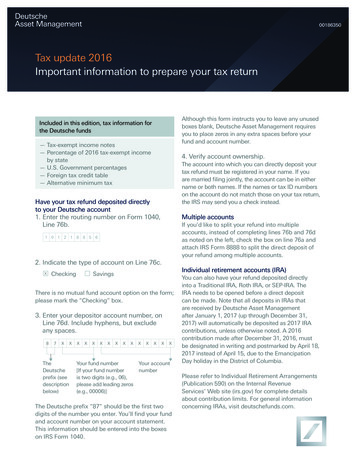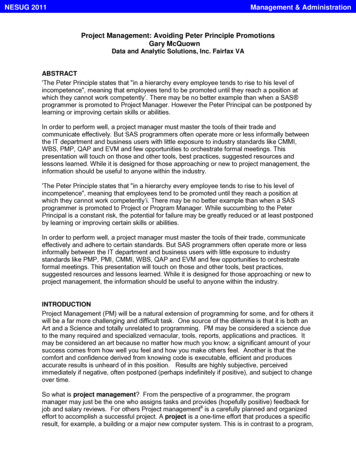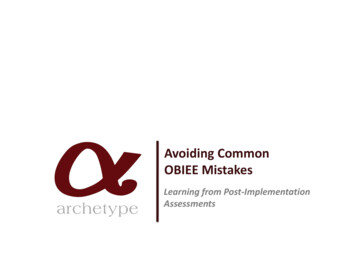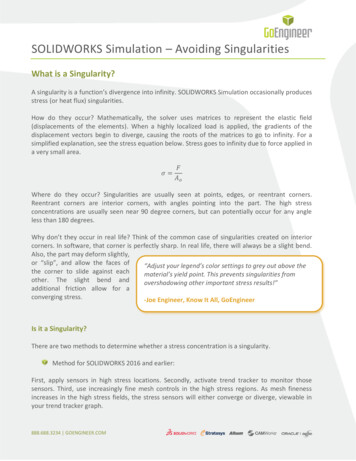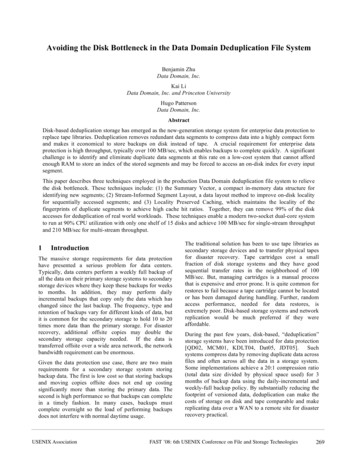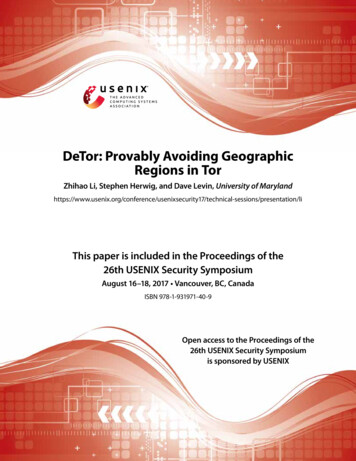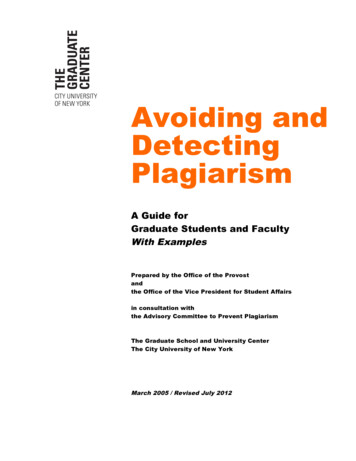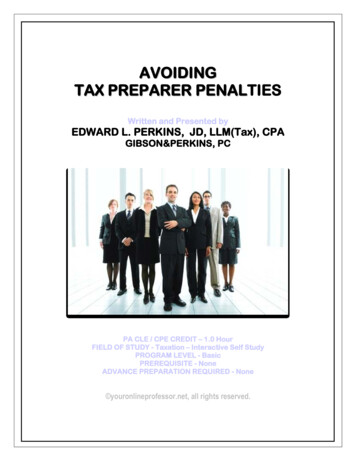
Transcription
AVOIDINGTAX PREPARER PENALTIESWritten and Presented byEDWARD L. PERKINS, JD, LLM(Tax), CPAGIBSON&PERKINS, PCPA CLE / CPE CREDIT – 1.0 HourFIELD OF STUDY - Taxation – Interactive Self StudyPROGRAM LEVEL - BasicPREREQUISITE - NoneADVANCE PREPARATION REQUIRED - None youronlineprofessor.net, all rights reserved.
AVOIDINGTAX PREPARER PENALTIESi
Course SummaryThis course will provide an overview of the potential penalties involved for tax return preparers and recentcode and policy changes in that regard.Your InstructorEdward L. Perkins, BA, JD, LLM (TAX), CPA - Mr. Perkins has been practicing as atransactional attorney for over twenty-five years. Mr. Perkins is a principal shareholder inthe firm and also a faculty member of the Graduate Tax Program at the Villanova LawSchool. In that program, he currently teaches "The Drafting Fundamentals of EstatePlanning Documents" - a course that he developed for the program and which is nowrequired for all those seeking the Program's Certificate in Estate Planning. In the past, hehas taught "Comparative Taxation of Business Entities", "Federal Estate and Gift Tax","Estate Planning", "Tax Research", "Taxation of Individual Taxpayers", "Taxation ofCorporations and Partnerships", "Advanced Tax Accounting", and "State and Local Taxation."Course ContentThe Practice Units are as follows:UNIT ONE - OverviewUNIT TWO – Who is a Tax Return Preparer?UNIT THREE – Section 6694(a)UNIT FOUR - Section 6694(b)UNIT FIVE – Who is the responsible Tax Return Preparer?UNIT SIX – Other Assessable PenaltiesUNIT SEVEN – Assessment ProcedureLearning ObjectiveThis Interactive webinar consists of Seven Practice Units.ii
iii
UNIT ONE – OverviewI.Tax Return Preparer Penalties.A.The Internal Revenue Code provides two penalty provisions, which specifically apply to taxreturn preparers, in Sec. 6694(a) and 6694(b).B.Anyone who prepares tax returns for compensation should be familiar with theseprovisions and what must be done to avoid penalties.C.This is particularly important because recent legislation has changed the standard bywhich tax return preparers will be judged under these provisions.1.In 2007 - The Small Business and Work Opportunity Tax Act (the ―Small BusinessAct‖) adopted tougher standards in regard to tax preparer penalties under Code Sec. 6694. Thesechanges were to be effective for returns prepared after May 25, 20072.In 2008 - The Emergency Economic Stabilization Act of 2008 (the ―EES Act‖),which was signed into law, repealed retroactively the changes made by the Small Business Actand enacted new standards for returns prepared after May 25, 2007.Note: The changes made by the Small Business Act and the EES Act relate only to the CodeSec. 6694(a) preparer penalty for understatements due to unreasonable positions.The harsher Code Sec. 6694(b) preparer understatement penalty for willful, reckless or intentionalconduct was unaffected.II.This Course.A.Among the questions to be answered by this Course are the following:1.What are the specific penalties under Code Secs. 6694(a) and 6694(b) whichapply to ―tax return preparers‖?2.When are you considered a ―tax return preparer‖ subject to these Code sections?3.What are the standards of practice that must be followed to avoid penalty underCode Secs. 6694(a) and 6694(b)?4.If there is more than one tax preparer with regard to a particular tax return, uponwhom can the penalty be imposed? And, can the firm employing those preparers also be heldliable?1
5.What is a preparer’s duty to verify the information provided by the taxpayer? Andcan I rely on information provided by other tax preparers? Or tax advisors? Or prior filed taxreturns?6.How do I conduct my practice to avoid these penalties?7.Are there any other penalties which apply to tax return preparers under the Code?2
UNIT TWO – Who is a Tax Return Preparer?I.Overview.A.Regulations - A ―tax return preparer” is defined by the Regulations as:1.Any person who prepares for compensation, or who employs one or more personsto prepare for compensation,2.All or a substantial portion of,3.Any return of tax or claim for refund of tax under the Internal Revenue Code.B.More Inclusive Definition - The definition is more inclusive than simply a person whoactually prepares the physical tax return and may include advisers rendering advice related to specificitems on the return.II.Definitions.A.Regulations - The Regulations define tax return preparers in terms of “signing tax returnpreparers”, and “nonsigning tax return preparers”.B.Signing Tax Return Preparer.A signing tax return preparer is the individual tax return preparer who physically signs the returnand normally has the primary responsibility for the overall substantive accuracy of the preparation of suchreturn or claim for refund.C.Nonsigning Tax Return Preparer.1.A nonsigning tax return preparer is any tax return preparer who is not a signing taxreturn preparer but who prepares all or a substantial portion of a return or claim for refund (asdiscussed in paragraph II.D., below) with respect to events that have occurred at the time theadvice is rendered.2.In determining whether an individual is a nonsigning tax return preparer, timespent on advice that is given after events have occurred that represents less than 5 percent of theaggregate time incurred by such individual with respect to the position(s) giving rise to theunderstatement shall not be taken into account.3.Notwithstanding, time spent on advice before the events have occurred will betaken into account if all facts and circumstances show that:a.the advice,The position(s) giving rise to the understatement is primarily attributable to3
b.The advice was substantially given before events occurred primarily toavoid treating the person giving the advice as a tax return preparer, andc.The advice given before events occurred was confirmed after events hadoccurred for purposes of preparing a tax return.4.Examples of nonsigning tax return preparers are tax return preparers who provideadvice (written or oral) to a taxpayer (or to another tax return preparer) when that advice leads to aposition or entry that constitutes a substantial portion of the return.5.Examples.The provisions of this section are illustrated by the following examples:Example 1. Attorney A, an attorney in a law firm, provides legal advice to a large corporatetaxpayer regarding a completed corporate transaction. The advice provided by A is directlyrelevant to the determination of an entry on the taxpayer's return, and this advice leads toa position(s) or entry that constitutes a substantial portion of the return. A, however, doesnot prepare any other portion of the taxpayer's return and is not the signing tax returnpreparer of this return.A is considered a nonsigning tax return preparer.Example 2. Attorney B, an attorney in a law firm, provides legal advice to a large corporatetaxpayer regarding the tax consequences of a proposed corporate transaction. Basedupon this advice, the corporate taxpayer enters into the transaction. Once the transactionis completed, the corporate taxpayer does not receive any additional advice from B withrespect to the transaction.B did not provide advice with respect to events that have occurred and is not considered atax return preparer.Example 3. The facts are the same as Example 2, except that Attorney B providessupplemental advice to the corporate taxpayer on a phone call after the transaction iscompleted. Attorney B did not provide advice before the corporate transaction occurredwith the primary intent to avoid being treated as a tax return preparer. The time incurred onthis supplemental advice by B represented less than 5 percent of the aggregate amount oftime spent by B providing tax advice on the position.B is not considered a tax return preparer.D.Definition of ―Substantial Portion‖.1.Only a person who prepares all or a “substantial portion‖ of a return or claim forrefund shall be considered to be a tax return preparer of the return or claim for refund.4
2.A person who renders tax advice on a position that is directly relevant to thedetermination of the existence, characterization, or amount of an entry on a return or claim forrefund will be regarded as having prepared that entry.3.In determining if a schedule, entry, or other portion of a return or claim for refund isa substantial portion, the decision is based upon whether the person knows or reasonably shouldknow that the tax attributable to the schedule, entry, or other portion of a return or claim for refundis a substantial portion of the tax required to be shown on the return or claim for refund.4.A single tax entry may constitute a substantial portion of the tax required to beshown on a return.5.Factors to consider in determining whether a schedule, entry, or other portion of areturn or claim for refund is a substantial portion include but are not limited to:a.income; andthe size and complexity of the item relative to the taxpayer's grossb.the size of the understatement attributable to the item compared to thetaxpayer's reported tax liability.6.For a nonsigning tax return preparer the schedule or other portion is notconsidered to be a substantial portion if the schedule, entry, or other portion of the return or claimfor refund involves amounts of gross income, amounts of deductions, or amounts on the basis ofwhich credits are determined that area.Less than 10,000; orb.Less than 400,000 and also less than 20 percent of the gross income asshown on the return or claim for refund (or, for an individual, the individual's adjusted grossincome).If more than one schedule, entry or other portion is involved, all schedules, entries or other portionsshall be aggregated in applying the de minimis rule in paragraph D6.7.A tax return preparer with respect to one return is not usually considered to be atax return preparer of another return merely because an entry or entries reported on the first returnmay affect an entry reported on the other return:a.Unless, the entry or entries reported on the first return are directlyreflected on the other return and constitute a substantial portion of the other return.b.For example, the sole preparer of a partnership return of income or smallbusiness corporation income tax return is considered a tax return preparer of a partner's ora shareholder's return if the entry or entries on the partnership or small businesscorporation return reportable on the partner's or shareholder's return constitute asubstantial portion of the partner's or shareholder's return.5
8.Example.Example 1. Accountant D prepares a schedule for an individual taxpayer's Form 1040,―U.S. Individual Income Tax Return‖, reporting 4,000 in dividend income and gives oral orwritten advice about Schedule A, which results in a claim of a medical expense deductiontotaling 5,000, but does not sign the tax return.D is not a nonsigning tax return preparer because the total aggregate amount of thedeductions is less than 10,000.E.Defining ―Return‖ and ―Claim For Refund‖.1.Definition of Return.a.A ―return‖ is a return (including an amended or adjusted return) filed by oron behalf of a taxpayer reporting the liability of the taxpayer for tax under the InternalRevenue Codeb.A ―return‖ also includes any information return or other documentidentified in published guidance in the Internal Revenue Bulletin and that reportsinformation that is or may be reported on another taxpayer's return under the Code if theinformation reported on the information return or other document constitutes a substantialportion of the taxpayer's return.2.Claim For Refund.a.A ―claim for refund‖ of tax includes a claim for credit against tax.b.A claim for refund also includes a claim for payment under section 6420(the tax on gasoline used on farms), 6421 (Gasoline for non-highway purposes, used bylocal transit, or sold for certain exempt purposes), or 6427 (fuels not used for taxablepurposes).F.Mechanical Or Clerical Assistance.1.A person who furnishes to a taxpayer or other tax return preparer sufficientinformation and advice so that completion of the return or claim for refund is largely a mechanicalor clerical matter is considered a tax return preparer, even though that person does not actuallyplace or review placement of information on the return or claim for refund.2.The mechanical assistance exception described in this paragraph is illustrated bythe following examples:Example 1.A reporting agent received employment tax information from a client fromthe client's business records. The reporting agent did not render any tax advice to theclient or exercise any discretion or independent judgment on the client's underlying tax6
positions. The reporting agent processed the client's information, signed the return asauthorized by the client pursuant to Form 8655, Reporting Agent Authorization, and filedthe client's return using the information supplied by the client. The reporting agent is not atax return preparer.Example 2.A reporting agent rendered tax advice to a client on determining whetherhis/her workers are employees or independent contractors for Federal tax purposes. Forcompensation, the reporting agent received employment tax information from the client,processed the client's information and filed the client's return using the informationsupplied by the client. The reporting agent is a tax return preparer.G.Qualifications.A person may be a tax return preparer without regard to educational qualifications and professionalstatus requirements.H.Outside The United States.1.A person who prepares a return or claim for refund outside the United States is atax return preparer, regardless of the person's nationality, residence, or the location of the person'splace of business, if, the person otherwise satisfies the definition of tax return preparer.2.Notwithstanding the provisions of rules for TINs issued to foreign persons, theperson shall secure an employer identification number if the person is an employer of another taxreturn preparer, is in a partnership in which one or more of the general partners is a tax returnpreparer, is in a firm in which one or more of the equity holders is a tax return preparer, or is anindividual not employed by another tax return preparer.I.Persons Who Are Not Tax Return Preparers.The following persons are not tax return preparers:1.An official or employee of the Internal Revenue Service performing official duties.2.Any individual who provides tax assistance under a Volunteer Income TaxAssistance (VITA) program established by the IRS, but only with respect to those returns preparedas part of the VITA program.3.Any organization sponsoring or administering a VITA program established by theIRS, but only with respect to that sponsorship or administration.4.Any individual who provides tax counseling for the elderly under a programestablished pursuant to Section 163 of the Revenue Act of 1978, but only with respect to thosereturns prepared as part of that program.7
5.Any organization sponsoring or administering a program to provide tax counselingfor the elderly established pursuant to Section 163 of the Revenue Act of 1978, but only withrespect to that sponsorship or administration.6.Any individual who provides tax assistance as part of a qualified Low-IncomeTaxpayer Clinic (LITC), as defined by Section 7526 but only with respect to those returns andclaims for refund prepared as part of the LITC program.7.Any organization that is a qualified LITC, as defined by Section 7526, subject tothe requirements of paragraph J below.8.An individual providing only typing, reproduction, or other mechanical assistance inthe preparation of a return or claim for refund.9.An individual preparing a return or claim for refund of a taxpayer, or an officer, ageneral partner, member, shareholder, or employee of a taxpayer, by whom the individual isregularly and continuously employed or compensated or in which the individual is a generalpartner.10.An individual preparing a return or claim for refund for a trust, estate, or otherentity of which the individual either is a fiduciary or is an officer, general partner, or employee of thefiduciary. For purposes of this paragraph, an estate, guardianship, conservatorship, committee, orany similar arrangement for a taxpayer under a legal disability (such as a minor, an incompetent, oran infirm individual) is considered a trust or estate.11.An individual preparing a claim for refund for a taxpayer in response to:a.A notice of deficiency issued to the taxpayer; orb.A waiver of restriction on assessment after initiation of an audit of thetaxpayer or another taxpayer if a determination in the audit of the other taxpayer affects,directly or indirectly, the liability of the taxpayer for tax.12.A person who prepares a return or claim for refund for a taxpayer with no explicitor implicit agreement for compensation, even if the person receives an insubstantial gift, returnservice, or favor.J.Employee. For purposes of paragraph I9, the employee of a corporation owning more than50 percent of the voting power of another corporation, or the employee of a corporation more than 50percent of the voting power of which is owned by another corporation, is considered the employee of theother corporation as well.8
UNIT THREE - §6694(a) - Penalty For Understatement Due ToAn Unreasonable PositionI.Background.A.Pre Small Business Act Law law provided the following:Before the changes made by the Small Business Act the1.The penalty was imposed in an amount equal to the greater of 1,000, or 50% ofthe income derived (or to be derived) by the tax return preparer for preparing the return or refundclaim.2.The penalty applied when (i) there wasn't ―a realistic possibility of a position beingsustained on its merits‖, (ii) the preparer knew or should have known this fact, and (iii) the positionwas undisclosed or frivolous.3.The penalty also was limited to income tax return preparers and did not apply topreparers of estate, gift, employment and other tax returns.4.A position was considered to have a ―realistic possibility of being sustained on itsmerits‖ if a reasonable and well-informed analysis by a person knowledgeable in the tax law wouldlead him to conclude that the position had approximately a one in three, or greater, chance of beingsustainedB.The Small Business Act.1.The Small Business Act provided that a tax return preparer was liable for a penaltyif he prepared any return or claim for refund for which any part of an understatement of liability wasdue to an “unreasonable position.”2.The standard applied, termed the “more likely than not standard”, provided that aposition was ―unreasonable‖ if all of the following applied:a.position,the tax return preparer knew (or reasonably should have known) of theb.there was not a reasonable belief that the position would “more likely thannot” be sustained on its merits, andc.the position wasn't properly disclosed or there was no reasonable basisfor the position.3.The “more likely than not” standard (i.e., a standard requiring a greater than 50%likelihood) created a strong backlash of criticism because it imposed a much stricter standard to tax9
preparer’s than the ―substantial authority standard‖ which applies to taxpayers preparing their ownreturns.C.The EES Act Repeals the ―More likely Than Not Standard‖.1.Repeal - The Emergency Economic Stabilization Act repeals retroactively the―more likely than not” standard for returns prepared after May 25, 2007, and replaces it with a“substantial authority standard”, except in the cases involving tax shelters, reportable transactionsand cases where adequate disclosure was made.2.The EES Act therefore effectively eliminates the discrepancy in standards that wascreated by the Small Business Act between tax preparers and taxpayers.II.Tax Return Preparer Penalties Under Code Sec. 6694(a).A.Sec. 6694(a).1.A tax return preparer is liable for a penalty unde
Edward L. Perkins, BA, JD, LLM (TAX), CPA - Mr. Perkins has been practicing as a transactional attorney for over twenty-five years. Mr. Perkins is a principal shareholder in the firm and also a faculty member

